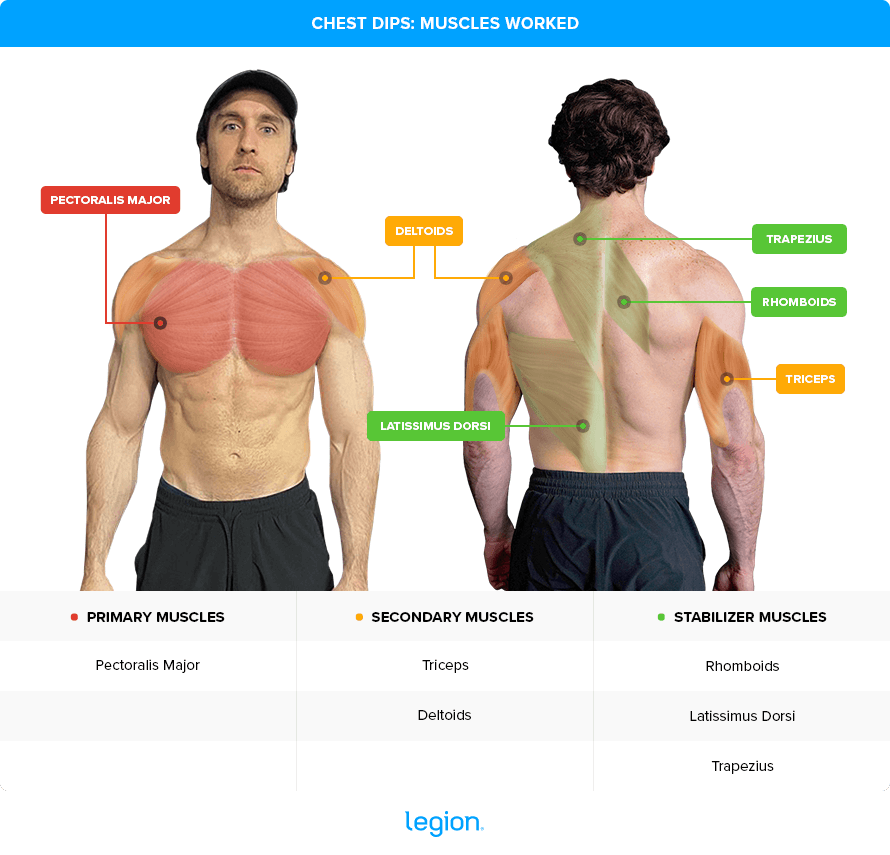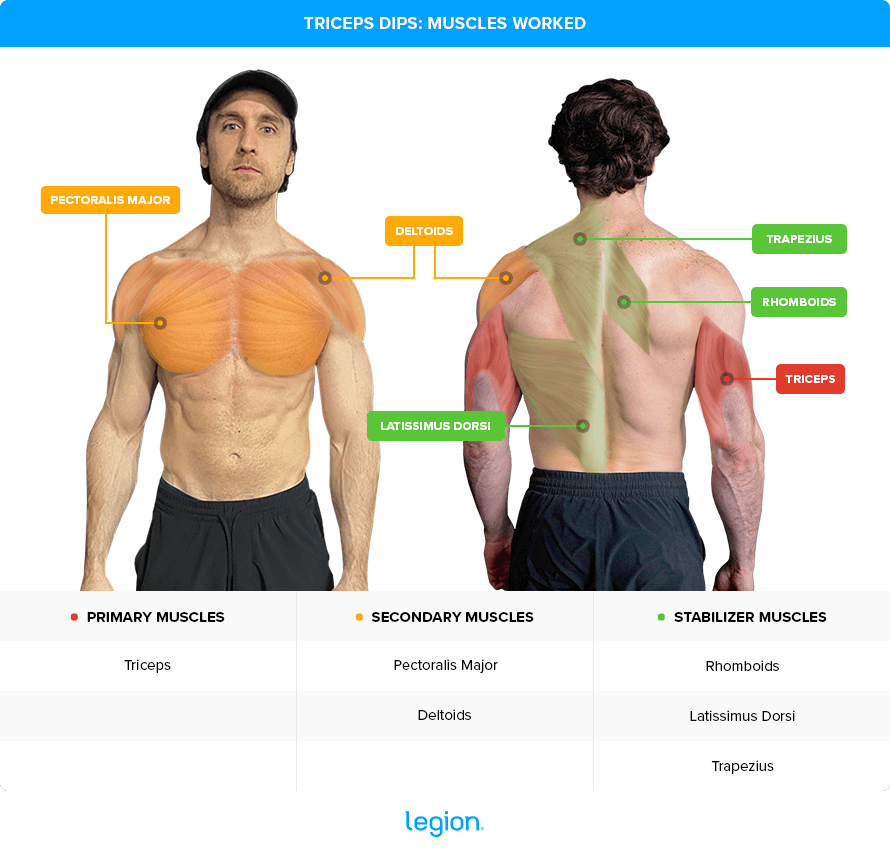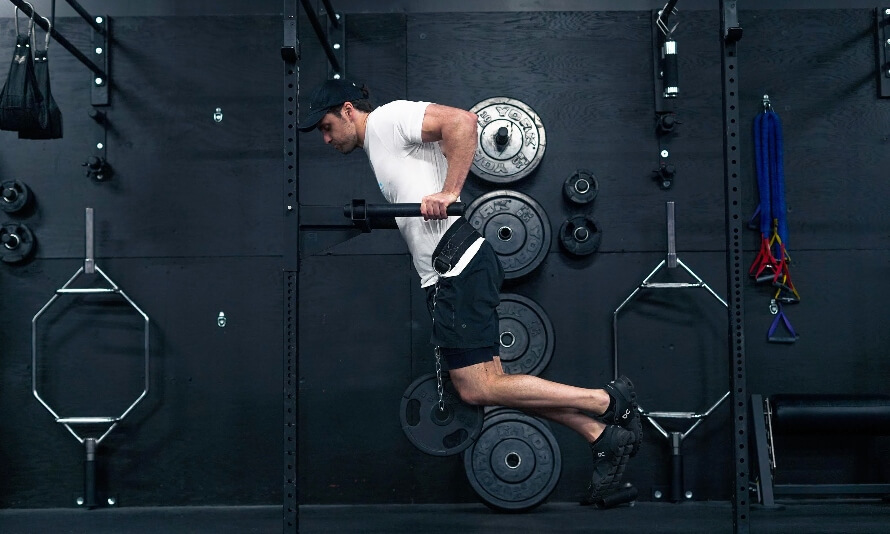“What muscles do dips work?” is a common query in the fitness space.
There are a couple of reasons for the uncertainty.
First, dips train several major and minor upper-body muscle groups simultaneously, which can make pinpointing the exact muscles worked by dips tricky. And second, the muscles that dips work can change depending on how you perform the exercise.
This expert guide is here to clear up any confusion.
In it, you’ll learn the various muscles worked by dips, how to perform common dip variations, why the dip is such a beneficial exercise, how to prevent injuries from dips, and more.
What Is a Dip?
A “dip” is an upper-body exercise where you support your weight with your arms, lower your body by bending your elbows, and then press yourself up until your arms are straight.
You can perform a dip on numerous pieces of equipment. The most common is a “dip station,” a sturdy metal frame with parallel bars designed for performing dips. Other popular options include parallel bars, a bench, gymnastics rings, or stable chairs.
Most people think of dips as a bodyweight exercise, though you can make them more challenging by strapping extra weight to your body using a dip belt or easier by performing them on an assisted dip machine.
Here’s what a dip looks like:

What Are the Muscles That Dips Work?
Many struggle to grasp which muscles that dips work for a couple of reasons.
First, dips are a compound exercise that work multiple muscle groups simultaneously. This can make it tricky to pinpoint precisely which muscles are working.
And second, you can shift which muscles you emphasize by making minor adjustments to how you perform the exercise. For example, by leaning slightly forward and allowing your elbows to flare 4-to-6 inches from your sides, you emphasize your pecs more than your triceps.
Conversely, if you keep your torso upright and elbows closer to your sides, you train your triceps slightly more than your pecs.
With this in mind, let’s take a closer look at the dips muscles worked for the chest and triceps dip:
Chest Dips: Muscles Worked
The main muscles worked by chest dips are the pectoralis major, or “chest muscles.” Chest dips also train your triceps and deltoids to a high degree.
While not a back exercise, chest dips also involve the rhomboids, trapezius (“traps”), and latissimus dorsi (“lats”) for stabilization.
Here’s how these muscles look on your body:

Triceps Dips: Muscles Worked
The main muscles worked by triceps dips are the triceps brachii, or “triceps.” Triceps dips also train your pecs and deltoids to a high degree.
Like the chest dip, triceps dips aren’t a back exercise, but involve the rhomboids, traps, and lats for stabilization.
Here’s how these muscles look on your body:

The Benefits of Dips
1. It trains several upper-body muscle groups.
The dip trains all your upper body “pushing” muscles, specifically the pecs, triceps, and shoulders (particularly the anterior deltoids or “front delts”).
Unlike many other pushing exercises, the dip is also a closed-kinetic-chain exercise—an exercise where your hands or feet are fixed on a stationary object.
One of the benefits of closed-kinetic-chain exercises is that they require more balance and stability than open-chain-kinetic exercises, which means they train “stabilizer” muscles across your entire body to a higher degree.
2. It’s highly scalable.
Lowering and lifting your whole body between two bars is tough, especially for beginners, which is why starting with full bodyweight dips is too difficult for many.
Fortunately, you can perform exercises, such as the bench dip and assisted chest dip, that help you build the strength necessary to progress to the regular dip.
Once you’re strong enough to do around 10-to-15 reps of bodyweight dips without resting, you can increase the difficulty by snatching a dumbbell between your thighs or strapping a weight plate around your waist using a dip belt.
In other words, the dip is highly scalable. Whether you’re starting out or already strong, there’s a version of the dip that’ll suit your experience level and challenge you to get stronger over time.
3. It’s gentle on your shoulders.
Unlike many other compound pressing exercises, such as the bench press and incline bench press, the dip involves a neutral grip (palms facing each other). Using a neutral grip keeps your forearms and upper arms aligned, minimizing shoulder stress.
This makes it ideal for people training around a shoulder injury or who find barbell pressing exercises uncomfortable.
How to Do the Most Common Dip Variations
1. Chest Dips
- If you’re using a dip belt, wrap the belt around your waist, add the desired weight to the chain, and fasten the carabiner.
- Grab both handles of a dip station, then gently jump off the ground and press through your arms until your arms are straight and supporting your body weight.
- Lean slightly forward, bend your knees to keep your feet from touching the ground, and lower your body by bending your elbows until your upper arms are roughly parallel to the floor.
- Press into the handles to drive your body up and return to the starting position.
2. Triceps Dips
- If you’re using a dip belt, wrap the belt around your waist, add the desired weight to the chain, and fasten the carabiner.
- Grab both handles of a dip station, then gently jump off the ground and press through your arms until your arms are straight and supporting your body weight.
- Keep your torso upright, bend your knees to keep your feet from touching the ground, and lower your body by bending your elbows until your upper arms are roughly parallel to the floor.
- Press into the handles to drive your body up and return to the starting position.
3. Triceps Bench Dips
- Sit on the edge of a flat bench with your hands next to your thighs, palms facing down, and your fingers gripping the edge of the bench.
- Walk 3-to-4 feet forward, then straighten your legs to support your weight on your hands and heels.
- Bend your elbows to lower your body until your upper arms are roughly parallel to the floor.
- Press through your hands to drive your body up and return to the starting position.
4. Ring Dips
- Attach two gymnastics rings shoulder-width apart from a sturdy point a few feet above head height.
- Grab a ring in each hand, then gently jump off the ground and press through your arms until your arms are straight and supporting your body weight.
- Bend your knees to keep your feet from touching the ground, and lower your body by bending your elbows until your upper arms are roughly parallel to the floor.
- Press into the rings to drive your body up and return to the starting position.
5. Assisted Dips
- Adjust the assisted dip machine weight stack to provide the necessary level of assistance.
- Stand on the footplates and grab the dip machine’s handles, then slide your knees onto the knee pad one at a time and straighten your arms to support some of your body weight.
- Bend your elbows to lower your body until your upper arms are roughly parallel to the floor.
- Press through your hands to drive your body up and return to the starting position.
Injury Precautions with Dips
It’s crucial to maintain proper form to avoid injuries when performing dips. Here are some key precautions:
- Shoulder Position: Keep your shoulders down and back. Raising or rolling them forward can strain the shoulder joints.
- Elbow Position: To protect the joints and engage the correct muscles, never flare your elbows more than 4-to-6 inches from your sides.
- Controlled Movement: Avoid “dropping” quickly. Lower and raise your body in a controlled manner to prevent undue stress on your shoulders and elbows.
- Range of motion: It’s generally best to train through a full range of motion. However, if doing so causes shoulder or chest discomfort, consider limiting the depth of your dip. Only lower yourself to a point that is comfortable and pain-free.

FAQ #1: Chest dips work which muscles?
The main muscles that chest dips work are the pecs, though they involve the triceps and shoulders to a high degree, too.
While they aren’t a back exercise per se, several back muscles, including the rhomboids, traps, and lats, play a vital role in stabilization during the exercise.
FAQ #2: What muscle do dips work the most?
It depends on how you perform the exercise: if you lean slightly forward, dips primarily train your pecs, whereas if you stay upright, they mainly train your triceps. That said, no matter how you perform them, the chest, triceps, and shoulders are the primary muscles worked by dips.
FAQ #3: Do dips work your back?
While your back muscles aren’t the primary muscles worked by dips, your traps, rhomboids, and lats must work hard to stabilize your torso during the exercise. In other words, your back muscles are involved in dips, but not enough to gain significant back muscle and strength.
Scientific References +
- Bagchi, Amritashish . A COMPARATIVE ELECTROMYOGRAPHICAL INVESTIGATION of TRICEPS BRACHII and PECTORALIS MAJOR during FOUR DIFFERENT FREEHAND EXERCISES. Apr. 2015.
- Kwon, Yoo Jung, et al. “The Effect of Open and Closed Kinetic Chain Exercises on Dynamic Balance Ability of Normal Healthy Adults.” Journal of Physical Therapy Science, vol. 25, no. 6, 2013, pp. 671–674, https://doi.org/10.1589/jpts.25.671.
- Kim, Mi-Kyoung, and Kyung-Tae Yoo. “The Effects of Open and Closed Kinetic Chain Exercises on the Static and Dynamic Balance of the Ankle Joints in Young Healthy Women.” Journal of Physical Therapy Science, vol. 29, no. 5, 1 May 2017, pp. 845–850, www.ncbi.nlm.nih.gov/pmc/articles/PMC5462684/, https://doi.org/10.1589/jpts.29.845.
- Escalante, Guillermo. “Exercise Modification Strategies to Prevent and Train around Shoulder Pain.” Strength and Conditioning Journal, vol. 39, no. 3, June 2017, pp. 74–86, https://doi.org/10.1519/ssc.0000000000000259.










